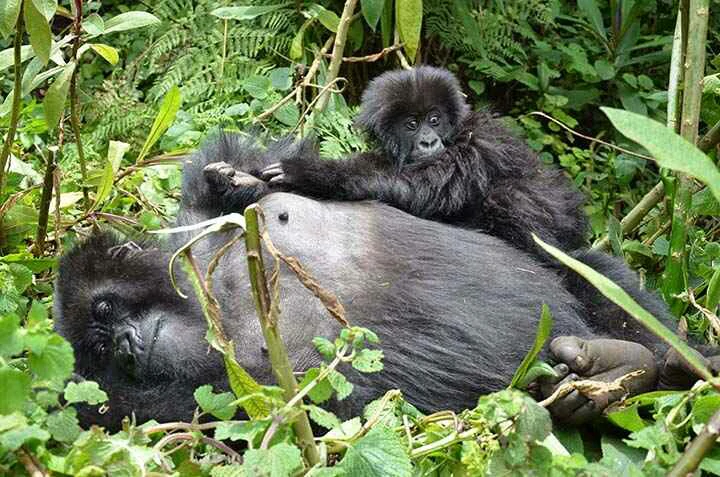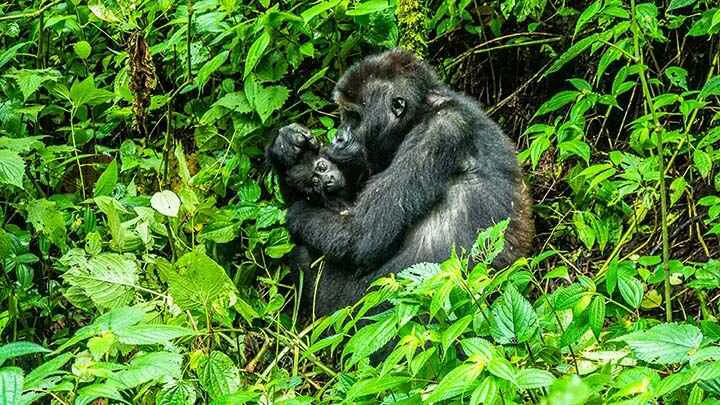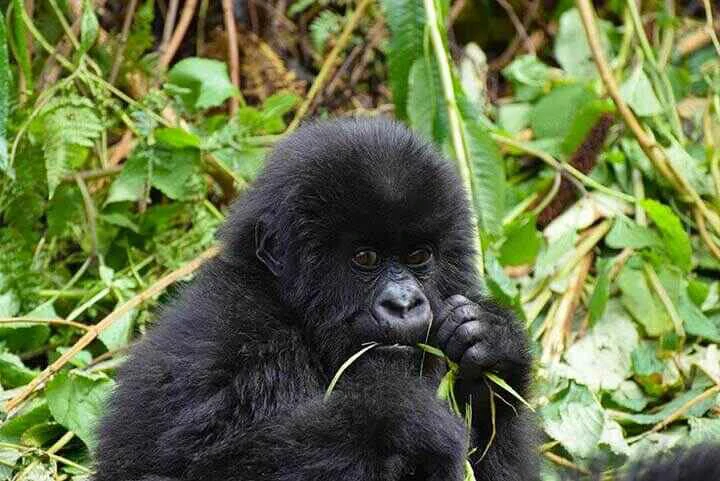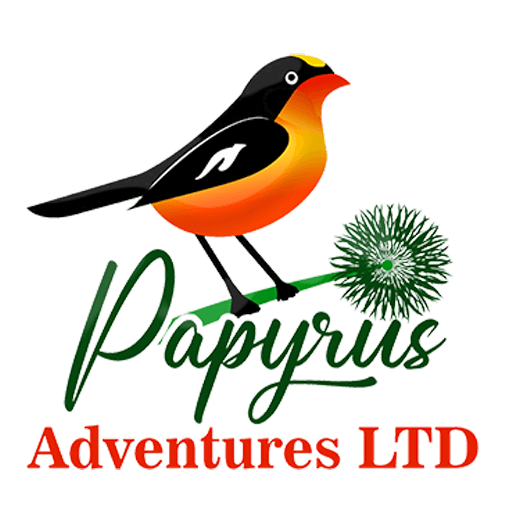Eastern Lowland Gorillas
The eastern lowland gorillas found only in the Democratic Republic of Congo are also known as the Grauer's gorillas are the largest of the four gorilla subspecies distinguished form other gorillas by their large hands, short muzzle and stocky body. In spite of their size, they feed on fruit and herbaceous foods. They make their homes in the lowland tropical rainforests of the Democratic Republic of Congo. Due to many years of civil unrest in the the Democratic Republic of Congo, the toll on eastern lowland gorillas and mountain gorillas has been enormous and throughout the unrest, the gorillas have been vulnerable to poaching. Kahuzi Biega National Park is the home to the largest population of protected eastern lowland gorillas. At this park rebels invaded and set up illegal mines but with the help of conservation agencies, the park authorities are regaining back control of the land. Maiko National Park also has some eastern lowland gorillas.
The Wildlife Conservation Society and other partners documented a disturbing drop in Grauer's gorilla numbers, from a projected 17,000 in 1995 to just 3,800 individuals. A current follow-up study led to this estimate being revised upwards to 6,800, but this is still less than half the number recorded a quarter of a century earlier.
Grauer's Gorilla Facts
- Grauer's gorillas are, on average, the largest of all gorilla subspecies. Males can weigh up to 250 kilos and reach two meters tall when standing
- Predominantly herbivorous and eat mainly plant matter (including fruit and bamboo), but sometimes they eat insects.
- Unlike other gorilla subspecies, if a group feels endangered, the whole family will stand its ground instead of fleeing.
- Grauer's gorilla lives in family groups and they are highly sociable animals, on average comprising between two to 30 individuals.
Due to high demand for bush meat, growing human population, civil unrest from armed groups, mining, logging and habitat loss to agriculture in the Democratic Republic of Congo, the Grauer gorillas are facing extinction and are declining in number. The Fauna and Flora International organization is working with local communities and authorities to conserve the eastern lowland gorillas and their habitat at in areas outisude the national parks through training and equipping community rangers. They also conduct patrols to monitor and record the presence of gorilla groups and other species like chimpanzees, peafowl and Okapis. Trained community ranges remove snares that can cause danger to the gorillas.
Do You have any Questions?
Our Experts are ready to provide answers
Gorilla families in Kahuzi biega
The park is a big protected area found in Eastern parts of South Kivu Province in DR Congo, positioned near the western bank of Kivu Lake, west of Bakavu town and Rwanda Border. Kahuzi Biega National Park inhabits eastern lowland gorillas which have 4 sub species of gorillas. Eastern lowland gorillas are among the largest living primates with a male eastern lowland gorilla standing at a maximum height of 1.85 meters and females height reaching 1.6metres. Females weighs 100 kg while a male weighs 210kgs. Eastern lowland gorillas are also communal primates that like living in groups of around 2-30 individuals.
Each family group has a dominant silverback alpha male leader and is made up of many females and the infants which are known to be their off springs. Silverbacks are the strongest gorilla group which has a task to protect their group from any danger. Young silverbacks are asked to leave their natal group and go to form their own groups and this is when they have reached at a mature level of forming their own groups In order to avoid disputes caused by competition over the head of the group. In reproduction, female eastern lowland gorillas give birth to one infant every birth and this happens after a gestation period of 8 and half month. Birth of twins is rare and in case of one it is highly welcome and celebrated by the group.
Kahuzi Biega National Park inhabits almost 9 families of the eastern lowland gorillas but only 5 went under habituation processes. Gorilla habituation process is a process where mountain gorillas undergo training for them to be used to human presence. These 5 families are the only families that are trekked in Kahuzi Biega national park and they include the following;
Mpungwe gorilla group
- Mpungwe gorilla family is the largest gorilla family among the habituated families found in Kahuzi Biega National Park and it is the most loved gorilla family and it is commonly trekked by the trekkers who love seeing lowland gorillas in large numbers. The Mpungwe gorilla group is made up of 21 family members.
Chimanuka gorilla group
- This is the second largest lowland gorilla group in the DRC that has attractive members. It has 19 family members under the leadership of a dominant silverback Chimanuka as a result the originality of the family name.
Mugahuka gorilla group
- It has 1 family member with one dominant silverback called Mugahuka. It was named after this dominant silverback. Mugahuka gorilla family comprised of both members but due to clashes between Chimanuka and Mugahuka gorilla family, it ended up losing its family members. Chimanuka gorilla family won the dispute hence females and infants were lost resulting Mugahuka dominant silverback remaining alone in the family group. Mugahuka gorilla family is recommended for less and elderly energetic trekker since it is the closest family to find in Kahuzi Biega.
Nganwa gorilla group
- This group it is undergoing habituation process and it is not yet open for gorilla trekking. The family is made up of 10 family members.
Bonnani gorilla family
- This is the lowest lowland gorilla family in the park and DRC. Bonnani gorilla family includes 5 gorilla members and it is among the newly habituated gorilla families in the park.
Travel With Us
When considering your next adventure, Papyrus Adventures stands out as the ideal travel companion, offering a comprehensive package of benefits that ensure an unparalleled experience.
Best Price Guaranteed
With our "Best Price Guaranteed" policy, you can rest assured that you are getting the most value for your investment.
Professional Safari Guides
Our commitment to excellence extends to our team of "Professional Safari Guides," who possess extensive knowledge and expertise, ensuring a journey filled with insightful and unforgettable moments.
Locally Owned Company
Papyrus Adventures is deeply rooted in the destinations we explore, allowing us to provide authentic and immersive experiences that showcase the rich cultures and landscapes of each location.
24-7 Customer Support
our "24-7 Customer Support" ensures that your needs are met around the clock, providing peace of mind and a safety net for any unforeseen circumstances.
What to bring for gorilla trekking
Some parts of the Democratic Republic of Congo have few good places where to acquire some of the essential things needed while on a safari. It is possible to get equipment in some of the towns like Bukavu and Goma but as a foreign traveler, locating the right outlet or shop may be challenging. It's advisable that acquire all the important items or equipment before coming to the Democratic Republic of Congo. No telecommunication network in Kahuzi-Biega national park except in the main town of Bukavu. The internet used at the park office is got from a large satellite dish and is only available during the day. Some of the important things to pack during your safari in Kahuzi Biega are:
- Waterproof clothing: Kahuzi-Biega is a park with vast rain forests which bring rains throughout the year. There is a dry and wet season but the rains can surprise at any time and that thus it is vital to travel with a rain jacket and warm clothing
- A sleeping Bag and sheets: In case you are planning on camping or setting up a tent in one of the campsites, you will find a sleeping bag and two bed sheets handy. A tent and sleeping bag can be hired each for $5 per night. Camping costs $50 without a tent. The $50 is for the food and guards
- A Flashlight: There is no hydro-electricity in this part of the DRC and most of the hotels use solar panels or generators that can still go off and leave you in pitch darkness.
- Mosquito Repellents: Your hotel room will probably have a mosquito net but the parasites also bite outside the rooms and even in the jungles. Make sure you sleep under a mosquito net.
- A camera: To capture the beautiful landscapes, animals and birds. The camera should be waterproof to be efficient in case of rains
- Adapters and batteries: For your laptop, phones and other telecommunication equipment. This will ensure that your devices are on throughout your time in the park. You are advised to travel with solar chargers for your devices if possible. Carry extra battery for any of your devices that cannot be recharged.
- Bottled drinking water and light snack: Hiking the mountains or tracking the gorillas may wear you out causing thirst and hunger. Recommended that you move with two bottles of drinking water and something light to eat in case you get hungry when an activity is extended.
- Medication: In case you have any medications prescribed by your doctor for any allergies or sickness, travel with them. The medical facilities in DR Congo are limited. Other medications to travel with include anti-diarrhea and pain killers. We advise that you take malaria pills two days before visiting East and Central Africa. You are required to present a yellow fever vaccination card before crossing over to DR Congo.
- Toilet paper and towel: Sometimes the activity can go on for longer than expected and you might need to ease yourself in a makeshift hole in the African Jungle, come prepared
Do You have any Questions?
Our Experts are ready to provide answers
Congo gorilla trekking rules and regulations
- It's only a maximum of eight individuals per day that are allowed to trek, this helps to reduce the spreading of diseases from humans to the mountain gorillas.
- It's only 15 years and over individuals allowed to trek
- Trekking Takes place during day time and it's between 8:00am to 7:00 pm
- Strictly 1 hour is allowed with the mountain gorillas.
- Not feeling well then it's advisable not to track.
- Always remain calm, Avoid direct eye contact in case the gorilla charges and stay calm until it moves away.
- It's important to protect the gorillas from any illnesses. Sick tourist isn't allowed tracking.
- While tracking and you developed an urge to cough turn away and cover your nose.
- It's recommended to keep distance from the primates between 5 to 7 meters because they can easily catch diseases from humans.
- Keep noise levels as low as possible; avoid pointing or using flash light when taking photos of the mountain gorillas.
- Always carry water proof & warm gears for the cool conditions within the mountains since it sometimes gets wet within the forest and comfortable walking shoes are of a great advantage.
- No smoking and no snacks during gorilla trekking.
- Don't touch the mountain gorillas at any time; always keep hands to yourself to avoid direct contact.
- Avoid littering within the forest and keep the trash to yourself.
Frequently Asked Questions About Gorilla Trekking in Kahuzi Biega
It is 30 km from Bukavu town which will take you almost 1 and half hours to drive to reach Kahuzi Biega national park which is found in the eastern parts of Democratic Republic of Congo near the western bank of Kivu Lake, west of Bakavu town and Rwanda Border. It can be accessed by road and air. The roads are under good conditions and allow free movement of vehicles to the park. Chartered flights are organized for those who want to use air transport and they land at Kavuma and Miti airport. You will use a vehicle from these airports to reach the park.
A moderate level of fitness is suitable for most trekkers. During the pre-trekking briefing, travelers are reminded to disclose their physical fitness to travelers so they can be given gorilla families suitable for them. The park will provide porters that you can hire to assist you carry your stuff while you trek. A local walking stick is an excellent aid. Carry the necessary stuff for your trek. Tourists who are physically fit are so certain of smooth gorilla trekking tours without challenges since being fit is one of the main essentials for every successful gorilla trip. Physical fitness is accentuated to avoid challenges that come along with long hiking hours and in areas of high altitudes. Mountain gorillas live in areas of higher altitudes, which take trekkers several hours of trekking before meeting the endangered species.
The DRC has two rainy seasons with the short season staring from October to November while the long rainy season beings from mid-March to end of May. The rainy season in Congo happens to be the best time for visitors to track gorillas in Kahuzi-Biega national park as well as Virunga national park. However, many tourists choose to travel to Congo between June to September to February since in these months, the amount of rain has reduced and it's sunny in most of the destinations. December is one of the busiest months of the year in most national parks in DR Congo; hence it's advisable to book gorilla trekking permits in advances.
Travelers are reminded to carry enough drinking water and energy giving snacks to keep them strong during hiking. Other must carry essentials on a gorilla safari are hiking boots to ease movements in the slippery muddy grounds, rain jackets for the unpredictable forest weather, hand gloves to prevent being hurt by thorny bushes, sun glasses and a hat for protection from direct sun



